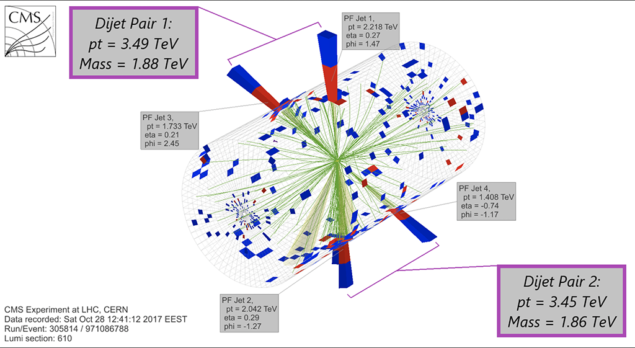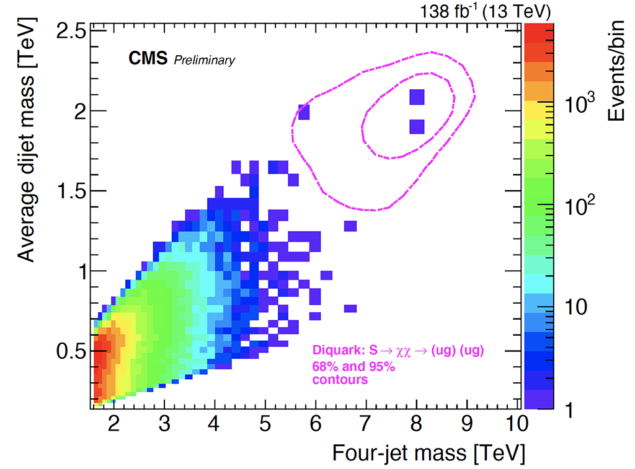A report from the CMS experiment.
The Standard Model (SM) has been extremely successful in describing the behaviour of elementary particles. Nevertheless, conundrums such as the nature of dark matter and the cosmological matter-antimatter asymmetry strongly suggest that the theory is incomplete. Hence, the SM is widely viewed as an effective low-energy limit of a more fundamental underlying theory which must be modified to describe particles and their interactions at higher energies.
A powerful way to discover new particles expected from physics beyond the SM is to search for high-mass dijet or multi-jet resonances, as these are expected to have large production cross-sections at hadron colliders. These searches look for a pair of jets originating from a pair of quarks or gluons, coming from the decay of a new particle “X” and appearing as a narrow bump in the invariant dijet-mass distribution. Since the energy scale of new physics is most likely high, it is natural to expect these new particles to be massive.

CMS and ATLAS have performed a suite of single-dijet-resonance searches. The next step is to look for new identical-mass particles “X” that are produced in pairs, with (resonant mode) or without (non-resonant mode) a new intermediate heavier particle “Y” being produced and decaying to pairs of X. Such processes would yield two dijet resonances and four jets in the final state: the dijet mass would correspond to particle X and the four-jet mass to particle Y.
The CMS experiment was also motivated to search for Y→ XX → 4-jets by a candidate event recorded in 2017, which was presented by a previous CMS search for dijet resonances (figure 1). This spectacular event has four high transverse-momentum jets, forming two dijet pairs each with an invariant mass of 1.9 TeV and a four-jet invariant mass of 8 TeV.

Presented on 14 March at Rencontres de Moriond, the CMS collaboration has found another very similar event in a new search optimised for this specific Y→ XX → 4-jets topology. These events could originate from quantum-chromodynamics processes, but those are expected to be extremely rare (figure 2). The two candidate events are clearly visible at high masses, distinct from all the rest. Also shown (magenta) is a simulation of a possible new-physics signal – a diquark decaying to vector-like quarks – with a four-jet mass of 8.4 TeV and a dijet mass of 2.1 TeV, which very nicely describes these two candidates.
The hypothesis that these events originate from the SM at the observed X and Y masses is disfavoured with a local significance of 3.9σ. Taking into account the full range of possible X and Y mass values, the compatibility of the observation with the SM expectation leads to a global significance of 1.6σ.
The upcoming LHC Run 3 and future High-Luminosity LHC runs will be crucial in telling us whether these events are statistical fluctuations of the SM expectation, or the first signs of yet another groundbreaking discovery at LHC.
Further reading
CMS Collaboration 2022 CMS-PAS-EXO-21-010.





